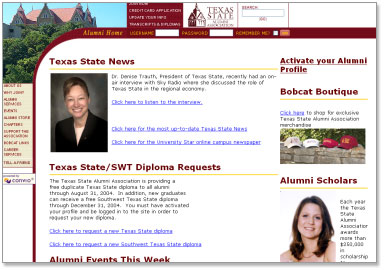|
Improving Communications with Alumni and Boosting Alumni Involvement: Texas State Alumni Association About Texas State Alumni Association Challenge The Association decided that the most cost-effective way to communicate with alumni and drive membership and involvement would be through the Internet. It sought an online solution to address several needs:
Convio helped the Association to plan, design and execute its online presence. The Association now uses Convio software for regular email communications, including a monthly email newsletter, and to power its entire Web site, including alumni services such as an events calendar and online store. Alumni can sign up online to become Association members, send email postcards with the university’s branding, post alumni notes, search for classmates through the online directory, sign up for newsletters or register for Association-sponsored regional events and more. Convio also helped the Association develop techniques to capture more alumni email addresses. For example, the Association advertised in its print magazine, informing alumni that they could visit the Web site to sign up for a copy of their diploma with the university’s new name. An alumnus who signs up is asked to activate his profile, which allows the Association to create a site user name and password matched to that alumnus’ university record in the Convio online database. The alumnus then can update his contact information and indicate his interests for future online communications from the Association. From that point on, the site recognizes the returning alumnus and gives him access to special content.
Results Better Outreach — The Association increased its list of email addresses from 3,500 to 13,000 by driving alumni to its Web site and asking them to register. Now the Association sends more frequent communications to its alumni, encouraging greater loyalty and involvement. As the Association acquires detailed knowledge about individuals, it personalizes emails according to each constituent’s interests and geographic location. Since implementing Convio, the Association has sent more than 325,000 individual email messages, with an average open rate of 32 percent. Within eight months, the Association achieved its goal of engaging in more frequent, personal interaction with alumni. Improved Alumni Services and Involvement — The Association now offers enhanced services online for alumni, including an online calendar, online store, a searchable alumni database and convenient online membership processing. The organization also communicates regularly with alumni at an individual level. Response has been strong. In the first five months of 2004, online membership was on track to increase 200 percent compared with 2003. In addition, the Association receives personal email messages — nearly 100 every day — from alumni responding to email messages or simply checking in to find out what is happening on campus. This interaction helps the Association develop a stronger, more loyal alumni base. Increased Efficiency and Cost Savings — With Convio’s easy-to-use software, just one staff member and a part-time associate manage the Association’s Web site and email communications. Using Convio to create email event notices and reminders, and then schedule delivery for future times and dates, the Association coordinated communications for more than 150 events across the nation in eight months. The Association also now automatically processes online memberships through Convio, cutting manual steps from the payment process. Plus, the Association saves money by allowing members to select online which premiums they want. Instead of sending a full packet of member premiums, the Association now excludes those — such as bumper stickers — that the member does not want or already has, saving these items for other members who do want them. Through increased online sales and donations, plus cost savings, the Association expects to more than pay for its investment in Convio within one year. Have a colleague who might be interested in this topic? Why not forward this article?
|
|




